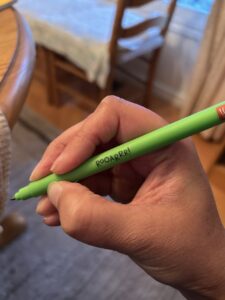In a recent blog post I shared 7 insights about hypermobility: what it is, why it matters, and how it shows up in children in ways that often get misunderstood. (If you missed that post, you can read it here.)
This week, let’s take a closer look at how hypermobility can affect children’s hands and fingers, and what that means for writing.
Hypermobility is really common alongside many diagnoses — including autism, ADHD, dyspraxia, Down’s syndrome, and more. It often shows up in handwriting difficulties… but the good news is, there are many ways to help.
Signs of Hypermobility in Hands and Fingers
These are some common writing struggles that suggest hypermobility may be part of the picture — so you know what to look out for.
Keep an eye out if your child:
-
Applies too little or too much pressure when writing
-
Wraps their thumb tightly or grips the pencil hard or awkwardly to feel more stable
-
Complains that their hands hurt or tire quickly
-
Slouches, leans on the table, or props their head in their hand
-
Often W-sits or twists themselves into unusual (sometimes yogi-like) seated positions to feel more stable
These patterns aren’t about laziness or poor posture. They’re often signs of hypermobility and low sensory feedback to the muscles and joints (what we call proprioception). This makes writing much harder than it looks.
The good news? Once we understand why it’s happening, we can step in and support them.
Why Body Alignment Matters
Hypermobility doesn’t just affect the hands. When joints are looser and the body isn’t getting strong signals back, kids often compensate with their whole posture and movement patterns.
This is why it’s so important to consider body alignment when supporting sensory and motor skills. A strong, stable base makes writing easier, less tiring, and far less painful.
How to Help If Your Child Has Hypermobility
If your child avoids writing, says their hands hurt, presses too hard, or tires easily, it’s valid. They’re not being lazy. In fact, they’re often working extra hard just to keep up.
Here are four ways to support them:
1. Honour the pain and protect joints
Teach your child to listen to their body. If their hands hurt, it’s okay to stop. Avoid overworking and respect what their body is telling them.
2. Use accommodations
Make writing easier with tools like fat pens, writing slopes, typing, scribing, or text-to-speech. The focus should be on your child’s ideas and expression not just how they hold a pencil.
3. Start with sensory support
Wake up the muscles and give the body sensory input before writing. This helps kids feel their bodies better and stabilise for the task ahead.
4. Build strength gradually
Support core and shoulder stability in small, playful ways. When the body is steady, fine motor control in the hands and fingers becomes much easier.
Here’s How I Can Help You Take the Next Step
This is the kind of work I do with families every day. If you’d like support, here are some ways we can work together:
1. Free Beyond Pencil Grasp Workshop
Learn where writing really begins — with sensory processing and body skills. Check here to see when the next one is and sign up ➝
2. Helping Kids Write Workshop (£29)
Discover your child’s sensory and motor skills, and get a programme of demonstrated activities to get started right away. Learn more here.
3. Foundations for Writing (10-week programme)
Go deeper with step-by-step guidance. Not only will you learn about your child’s underlying skills, but we’ll actually build them together. You’ll get video tutorials, activity demos, and support from me in a private FB group and live group Q&As. Check to learn when the next one is here
4. 1:1 brainstorm sessions
For personalised guidance, you can book a private session with me. Reach out through my contact page.
✨ The bottom line: If your child struggles with writing because of hypermobility, it’s not about motivation or effort. Their body is working overtime. With the right support, writing can feel more comfortable, less tiring, and far less of a battle.



